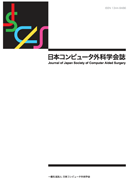
- Issue 4 Pages 273-
- Issue 3 Pages 83-
- Issue 2 Pages 45-
- Issue 1 Pages 3-
- |<
- <
- 1
- >
- >|
-
Yoshihiro Kakeji2024 Volume 25 Issue 4 Pages 273
Published: 2024
Released on J-STAGE: March 30, 2024
JOURNAL RESTRICTED ACCESSDownload PDF (139K)
-
[in Japanese]2024 Volume 25 Issue 4 Pages 275-277
Published: 2024
Released on J-STAGE: March 30, 2024
JOURNAL RESTRICTED ACCESSDownload PDF (3075K)
-
Kazuya Kawamura, Ayaka Matsui, Ryoichi Nakamura, Nobuyoshi Otori2024 Volume 25 Issue 4 Pages 278-286
Published: 2024
Released on J-STAGE: March 30, 2024
JOURNAL RESTRICTED ACCESSEndoscopic sinus surgery (ESS) is a surgery that requires advanced skills such as the surgeon holding an endoscope with one hand and operating a surgical instrument with the other hand. Surgeons require daily training to ensure safe surgical performance of ESS because ESS was required the high-level surgical technique. In this study, we focused on the development of an objective and quantitative skill evaluation method without high-cost sensor devices in the ESS training environment. In this paper, we aimed to examine the evaluation indexes using three-dimensional forceps motion information including depth for the quantitative evaluation of techniques in ESS training. We used future based method (ORB-SLAM) for measuring the motion information of endoscope and forceps during the training task. We performed the training using a nasal bone model simulated the ESS environment by 18 otolaryngologists. We measured the 12 indexes for evaluating the endoscope and forceps operation. And we also compared the results between skilled and unskilled surgeons in each index. From the results, we confirmed no significant difference, but some indexes showed different tendencies between skilled and unskilled surgeons. We suggested that some indexes could have different tendencies between skilled and unskilled surgeons. Thus, we will examine the task content and continue to measure all the indexes during the training task by increasing the number of subjects.
View full abstractDownload PDF (642K) -
―Development of a Master Device that can Present a Stable Force Sensation―Keiya Kato, Akihiko Hanafusa, Motoki Takagi, Shahrol Mohamaddan, Kazuy ...2024 Volume 25 Issue 4 Pages 287-296
Published: 2024
Released on J-STAGE: March 30, 2024
JOURNAL RESTRICTED ACCESSInterventional radiology (IVR) is a surgery, by which a catheter is inserted into a blood vessel and the treatment is performed under X-ray fluoroscopic images. However, the occupational exposure of the physician is a problem. To prevent occupational exposure, a remote surgery system has been developed by which the master device is operated by the surgeon and the slave device drives the catheter. In this study, a master device is developed to provide a stable force sensation. This master device presents force sensation by the characteristics of electro attractive material (EAM) by which force can be controlled by the applied voltage. The disadvantage of existing device was the unstable force sensation. By the newly developed device, the tip and the rear end of the ball screw were fixed using a shaft, and the eccentricity of the ball screw was reduced. Traction experiment was conducted by changing voltage applied to the EAM and eccentricity and traction force were measured. The eccentricity was reduced from 2.2 to 0.79 [mm] by 64% in vertical direction and from 1.6 to 0.85 [mm] by 47% in horizontal direction, and the maximum standard deviation of the traction force was reduced from 1.2 to 0.43 [N].
View full abstractDownload PDF (2542K)
-
2024 Volume 25 Issue 4 Pages 297-300
Published: 2024
Released on J-STAGE: March 30, 2024
JOURNAL RESTRICTED ACCESSDownload PDF (393K) -
2024 Volume 25 Issue 4 Pages 311
Published: 2024
Released on J-STAGE: March 30, 2024
JOURNAL RESTRICTED ACCESSDownload PDF (143K)
- |<
- <
- 1
- >
- >|